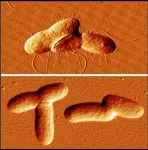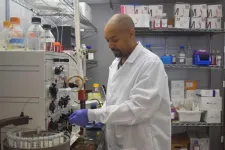(Press-News.org) If your teeth have ever felt fuzzy after skipping a brushing, you’ve encountered biofilm—a slimy bacterial layer that clings to surfaces. In medical settings, biofilms make infections harder to treat when they form protective shields for bacteria on devices like catheters and implants.
UC Riverside scientists have now discovered a chemical that plants produce when they're stressed prevents biofilm from forming. The breakthrough offers potential advances in healthcare as well as preventing equipment corrosion in industrial settings.
“In simple terms, biofilms are communities of microorganisms, like bacteria or fungi, that stick together and form a protective layer on surfaces,” said Katayoon Dehesh, distinguished professor of molecular biochemistry at UCR, and corresponding author of a study about the discovery.
“You’ve probably seen them as the slimy layer on river rocks or the plaque on your teeth. While they’re a natural part of many ecosystems, biofilms can cause big problems.”
The study, published in the journal Nature Communications, highlights the importance of a particular metabolite, which is a molecule produced during life-sustaining chemical reactions inside plants, as well as bacteria and even some parasites, like the one that causes malaria.
In plants, this metabolite, MEcPP, plays a critical role not only in producing essential compounds but also in stress signaling. For example, when a plant is damaged in some way and too much oxygen enters its cells, it accumulates MEcPP. This molecule then triggers protective responses within the plant. The researchers discovered that this same molecule has a surprising effect on bacteria like E. coli: it disrupts biofilm development by interfering with its ability to attach to surfaces.
In medical settings, biofilms grow on devices like catheters, stents, or implants, making infections harder to treat because the microbes in biofilms are highly resistant to antibiotics. In industrial contexts, they clog pipes, contaminate food processing equipment, and cause corrosion.
“By preventing the early stages of biofilm development, this molecule offers real potential to improve outcomes in any industries reliant on clean surfaces,” Dehesh said.
Bacteria rely on hair-like structures called fimbriae to anchor themselves to surfaces, a critical step in biofilm initiation. Fimbriae help bacteria latch onto medical implants, pipes, or even teeth, where they secrete a protective matrix that shields them from antibiotics and cleaning agents. Without fimbriae, biofilm formation cannot begin.
“Biofilms are like fortresses for bacteria,” said Jingzhe Guo, UCR project scientist and first author of the paper. “By disrupting the initial phase of attachment, MEcPP essentially disarms the bacteria’s ability to establish these fortresses.”
Through genetic screenings of more than 9,000 bacterial mutants, the research team identified a key gene called fimE, which acts as an "off switch" for fimbriae production. MEcPP enhances the activity of this gene and increases the expression of fimE. This, in turn, prevents the bacteria from producing fimbriae and forming biofilms.
“Our discovery could inspire biofilm prevention strategies across a wide range of industries,” Guo said. “From cleaner water systems to better dental care products, the possibilities are immense.”
Biofilms are not only a medical concern but also a costly problem in industrial settings. They contribute to clogged pipelines, corroded machinery, and contamination in food processing facilities. Traditional methods for managing biofilms often rely on harsh chemicals or expensive treatments, which can be harmful to the environment or ineffective over time as bacteria adapt.
“This study is a testament to the unexpected connections between plant biology and microbiology,” Guo said. “It’s thrilling to think a molecule that plants use to signal stress might one day help humans combat bacterial threats.”
END
Dangerous bacterial biofilms have a natural enemy
Discovery could help prevent infections
2025-01-10
ELSE PRESS RELEASES FROM THIS DATE:
Food study launched examining bone health of women 60 years and older
2025-01-10
Hinda and Arthur Marcus Institute for Aging Research investigators at Hebrew SeniorLife have launched a large clinical food trial to test whether a combination of probiotics and prebiotics (BondiaÒ or SBD111) developed by Solarea Bio will help manage bone health in women aged 60 years and above. The first participants have joined the study and the Institute seeks additional women for the 18-month effort.
“I am very happy to be involved in this important research to help with bone health in women,” says study participant Kathy ...
CDC awards $1.25M to engineers retooling mine production and safety
2025-01-10
From mapping ore to predicting slope behavior and reclaiming land, mining is a rapidly evolving technological industry. Yet planning and operations have not necessarily kept up with the advancements.
With $1.25 million from the National Institute for Occupational Safety and Health, or NIOSH, mining and geological engineering researchers in the University of Arizona College of Engineering are boosting their efforts to better align technology and planning for improved safety and productivity.
The award from the institute, part of the Centers for Disease Control and Prevention, will fund the research ...
Using AI to uncover hospital patients’ long COVID care needs
2025-01-10
PHILADELPHIA— Across the United States, no hospital is the same. Equipment, staffing, technical capabilities, and patient populations can all differ. So, while the profiles developed for people with common conditions may seem universal, the reality is that there are nuances that require individual attention, both in the make-up of the patients being seen and the situations of the hospitals providing their care.
New research shows that artificial intelligence can potentially help improve care overall by combing through ...
$1.9M NIH grant will allow researchers to explore how copper kills bacteria
2025-01-10
TUCSON, Arizona — A researcher at the University of Arizona College of Medicine – Tucson received a $1.9 million grant from the National Institutes of Health to continue his research into uncovering the mysteries of copper – specifically, how it can be harnessed to kill harmful bacteria and other microorganisms.
“We started using copper tens of thousands of years ago to cut down on bacterial infections,” said Michael D.L. Johnson, PhD, an associate professor ...
New fossil discovery sheds light on the early evolution of animal nervous systems
2025-01-10
Embargoed until Friday 10-Jan-2025 14:00 ET (10-Jan-2025 19:00 GMT/UTC)
An international team of scientists has uncovered a fascinating piece of the evolutionary puzzle: how the ventral nerve cord, a key component of the central nervous system, evolved in ecdysozoan animals, a group that includes insects, nematodes, and priapulid worms. Their findings, published in Science Advances, provide valuable insights into the origins of these structures in the basal Cambrian period.
The research team, comprising Dr Deng Wang (Northwest University), Dr Jean Vannier (Université ...
A battle of rafts: How molecular dynamics in CAR T cells explain their cancer-killing behavior
2025-01-10
HOUSTON – (Jan. 10, 2025) – A study published in Science Advances shares new insights into how two of the most common types of chimeric antigen receptor (CAR) T cells kill cancer. Investigators from Baylor College of Medicine, Texas Children’s Cancer Center and the Center for Cell and Gene Therapy at Baylor, Houston Methodist Hospital and Texas Children’s Hospital examined how molecular dynamics at the immune synapse – where CAR T cells bind to cancer cells – affect anticancer activity.
In this study, researchers aimed to understand how CAR T cells with different signaling domains work at the molecular and cellular levels to lay the ...
Study shows how plant roots access deeper soils in search of water
2025-01-10
Scientists have discovered how plants adapt their root systems in drought conditions to grow steeper into the soil to access deeper water reserves.
Plant scientists from the University of Nottingham, in collaboration with Shanghai Jiao Tong University, have identified how abscisic acid (ABA), a plant hormone known for its role in drought response, influences root growth angles in cereal crops such as rice and maize. The results have been published in Current Biology.
The study highlights how ABA and auxin, another key hormone, work together to shape root growth ...
Study reveals cost differences between Medicare Advantage and traditional Medicare patients in cancer drugs
2025-01-10
A new study examining the use of high-cost drugs among patients with colorectal cancer and non-small cell lung cancer found those insured through Medicare Advantage received less expensive cancer drugs compared to others on Traditional Medicare.
The findings were published today in JAMA Health Forum.
"Lung cancer is the leading cause of cancer-related deaths in the United States and colorectal cancer ranks third. Gaining a better understanding of treatment options and their costs under different insurance plans is important for assessing the overall healthcare landscape and how insurances manage patient costs,” said the study’s first author Cathy Bradley, PhD, Dean ...
‘What is that?’ UCalgary scientists explain white patch that appears near northern lights
2025-01-10
A whitish, grey patch that sometimes appears in the night sky alongside the northern lights has been explained for the first time by researchers at the University of Calgary.
The article, which was published on Dec. 30 in the journal Nature Communications, explores a “structured continuum emission” that’s associated with aurora borealis.
“You’d see this dynamic green aurora, you’d see some of the red aurora in the background and, all of a sudden, you’d see this structured – almost like a patch – grey-toned or white toned-emission connected to the aurora,” says Dr. Emma Spanswick, ...
How many children use Tik Tok against the rules? Most, study finds
2025-01-10
How many children use Tik Tok against the rules? Most, study finds
As the U.S. Supreme Court considers whether Congress can ban Tik Tok, new research highlights the health risks that top social media platforms pose to children.
Most 11- and 12-year-olds use Tik Tok and other social media despite the platforms’ age restrictions, and many show signs of addiction to social media, a new UC San Francisco study found.
Tik Tok, Instagram, YouTube, and Snapchat require users to be at least 13 years old to have an account. But the study found that a majority of 11- and 12-years olds across the country have accounts on the platforms, ...
LAST 30 PRESS RELEASES:
Deep neural networks enable accurate pricing of American options under stochastic volatility
Collective risk resonance in Chinese stock sectors uncovered through higher-order network analysis
Does CPU impact systemic risk contributions of Chinese sectors? Evidence from mixed frequency methods with asymmetric tail long memory
General intelligence framework to predict virus adaptation based on a genome language model
Antibiotic resistance is ancient, ecological, and deeply connected to human activity, new review shows
Vapes, pouches, heated tobacco, shisha, cigarettes: nicotine in all forms is toxic to the heart and blood vessels
From powder to planet: University of Modena engineers forge a low-carbon future for advanced metal manufacturing
Super strain-resistant superconductors
Pre-school health programme does not improve children’s diet or physical activity, prompting call for policy changes, study finds
Autumn clock change linked to reduction in certain health conditions
AI images of doctors can exaggerate and reinforce existing stereotypes
Where medicine meets melody – how lullabies help babies and parents in intensive care
We may never be able to tell if AI becomes conscious, argues philosopher
AI video translation shows promise but humans still hold the edge
Deep ocean earthquakes drive Southern Ocean’s massive phytoplankton blooms, study finds
Without campus leftovers to pick through, the beaks of this bird changed shape during the pandemic
High-dose antibiotic does not reduce mortality in tuberculous meningitis
How many insects fly in the sky above the USA?
Could cheese protect your brain health?
Who faces more difficulty recovering from stroke?
Colliding galaxies create the brightest, fastest growing black holes at their center
New BrainHealth research reveals tradeoffs on sleep with cannabis use for chronic pain
Aging-US now on ResearchGate, enhancing visibility for authors and readers
'Molecular glue' stabilizes protein that inhibits development of non-small cell lung cancer
Mount Sinai Health System is recognized in 2025 Chime Digital Health Most Wired survey
From prey to predator: How carnivores spread beneficial fungi
Menopause symptoms may be frequent and have negative effects, according to female endurance athletes
US Congressmembers’ responses on X to mass shooting events differ along party lines
KAIST-UEL team develops “origami” airless wheel to explore lunar caves
Individual genetic differences render some therapies ineffective
[Press-News.org] Dangerous bacterial biofilms have a natural enemyDiscovery could help prevent infections




